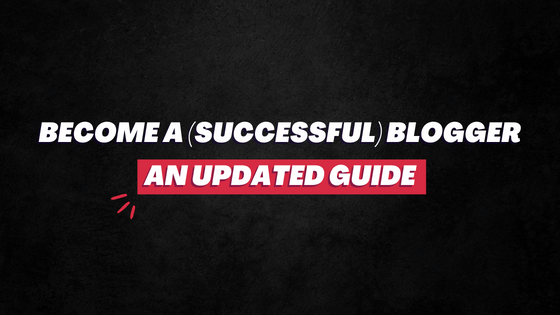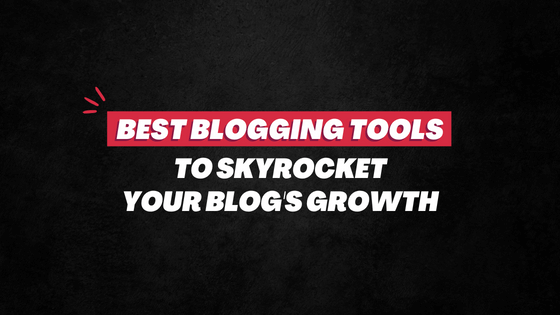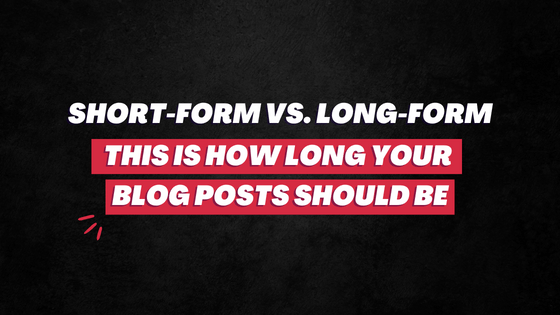You’re not alone.
Many people start a blog excitedly – usually after reading the success stories and income reports of other bloggers.
They blog for some days.
And then that excitement meets a roadblock.
Reality hits in: Increasing blog traffic and making money from blogging isn’t easy.
Their motivation fades.
They eventually stop.
So, if you’ve gone through this same journey – don’t worry… You are not alone!
But for whatever reason, if you now want to make a comeback – knowing how to get it right this time is important.
In this post, I cover 19 tips on how you can restart a blog after months of ignoring it.
I touch on various points here: how to restart the blog, increase blog traffic, make money online from your blog, and, most importantly, how you can stay motivated this time.
Let’s dive in!
1. Why did you stop the first time?
This is an important question that needs to be addressed and resolved so that the same reason doesn’t come your way again.
So, why did you stop blogging the first time?
Did the low traffic disappoint you? Were you not happy with the blogging niche you picked? Is it because you didn’t make money blogging that you were hoping for? Did you not like the domain name enough?
Ask such tough questions and find out the exact reason that made you stop blogging the first time.
Resolving such problems isn’t difficult. For instance, if you didn’t get sufficient blog traffic and that was the ‘reason’, this time you will have to work out other ways to increase organic traffic. If you were not happy with your niche, you now should pick a good blogging topic. The solutions are pretty straightforward.
The important thing is to first be aware of the problem.
Recommended Read: How To Find The Best Blogging Topic That Makes Money?
It will take you some time to create an editorial calendar and start publishing blog posts.
Don’t wait until then.
Meanwhile, get the wheels running almost immediately.
Start posting content on your social media accounts. This is either on your own account or dedicated social media profiles of your blog.
If you don’t have social media accounts on all major platforms, create quickly.
3. Write emails for the drip campaign
Building an email list is one of the most important things for bloggers.
However, even though it’s a common blogging tip, many beginners overlook this. Don’t be one of them!
Prepare for this right from the go.
Write down a series of emails (which would be your lead magnet) and put them on automation.
[Example: “7-Day Training That Will Make You a Morning Person”, “11-Day Email Course on How to Start a Blog”, “21 Days, 21 Emails That Will Change Your Bad Eating Habits”]
This will ensure you’re building an email list from the first day… And that your email subscribers are engaged for a month or so – without you manually handling anything.
Recommended Read: Ultimate Email Marketing Guide 2020 (Beginners + Advanced)
4. Figure out what to do with your old content
If you have published blog posts the last time, decide on what to do with them now.
You can repurpose and update them. You can delete them. You can leave them untouched.
It depends on the quality of those blog posts, as well as how different your new blogging strategy is vs. the strategy and approach the previous time.
If those blog posts are of bad quality or/and don’t fit how you want to take forward your blog – do not hesitate to delete them.
Recommended Read: How to Update Old Content to Boost SEO? (15 Actionable Steps)
5. Does the blog need a design overhaul?
This is a great time to make needed changes in your blog’s design.
So, if you don’t like how your blog looks and performs, make changes.
There are countless free and premium themes/templates out there.
Depending on the CMS you’re using and the niche you’re in, pick the theme accordingly.
If you’re confused, look at your successful competitors and the kind of blog design they have. Pick a theme that’s similar to them.
Irrespective of the theme you pick, make sure it doesn’t slow down your blog. Aim to have your blog load in less than 5 seconds. Anywhere between 2 and 3 seconds is great.
Remember, website speed, which influences User Experience, will affect your SEO.
At the same time, do not obsess over the blog design. It will never be “perfect”. You will have to make continuous improvements and changes as your blog grows.
So, pick a good theme that matches industry standards and go along with it without overthinking.
6. Create a (realistic) editorial calendar
Let me guess: You didn’t have an editorial calendar during your first attempt at blogging. Did you?
The Editorial Calendar is important.
It helps you stay on the right track, makes you consistent, and adds a strategic edge as to how you’re growing your blog.
Without it, you’re basically producing content blindly with no definite and integrated purpose.
So, create an editorial calendar for your blog.
How?
I’ve covered this step-by-step in a separate post. It’s a quick read. Check it out here: How to Create Editorial Calendar? Quick Step-By-Step Process
7. Publish as much content as you can
This is quite forward and there should be no confusion around this…
To become a successful blogger, you need to produce high-quality, highly valuable, and relevant content.
And today, quantity matters just as much as quality.
So, now you’re re-starting as a blogger, try to publish as much content as you can. This includes on your blog, social media channels, distribution platforms, and anywhere else that’s relevant.
The more content you produce, the more opportunities you will discover in your blogging journey.
8. Increase your brand awareness through guest blogging
Link building has never been a part of my SEO strategy. It shouldn’t be yours either.
Natural backlinks, which search engines recommend, aren’t built – they are earned.
While guest blogging is a popular off-page SEO technique to get backlinks, it’s a bad strategy that Google advises against.
In a Tweet, Google’s John Mueller said:
“…we have a lot of training data for our algorithms. I wouldn’t be surprised if the largest part of those links [got from guest posts] are just ignored automatically. If all that work is for ignored links, why not just do something useful instead?”
Guest blogging for backlinks is not a good idea, despite it being very popular.
Besides, I believe that as we move forward, backlinks would become less important than they used to be. I even wrote about this. Please check out: Backlinks Are Dead
But all said, it doesn’t mean you should not guest blog at all.
Guest blogging is a great way to boost your brand awareness.
And since you’re restarting your blog, it would certainly do well if you try to increase your brand awareness.
A strongly positioned brand will lead you to massive success.
So, this time, alongside focusing on how to increase blog traffic, also focus on how to build your brand. Guest blogging is one of those ways.
9. Tell a refined brand story
A branding strategy without storytelling is virtually useless and will inevitably fail.
Inbound marketing becomes more effective when you incorporate relevant and personalized stories in it.
So, be it in your ‘About’ page or/and blog posts – tell your story more openly and prevalently.
In that story, also include how you took a break from blogging, why you took it, and why you’re starting again.
Integrating such intimate, detailed, and updated insights into your brand story will help you in driving higher engagement, conversion, and retention.
You need more brand exposure.
You need more organic traffic.
Getting more social media shares on your blog posts will help you achieve both.
Admittedly, trying to get people to share your blog post is far from easy. But there are a few things you can do to increase the chances of getting more social media shares.
- Place social media share buttons more prominently, which are easier to see and access.
- Have floating social media buttons. Also, have them at the end of your blog post. (Like you see on this page if you’re on the desktop.)
- If you’re including quotes, statistics, or other interesting one-liners, include the “Click To Tweet” buttons along with them to encourage sharing.
- Ask the visitors to share your blog post if they found the content helpful. Be upfront. Let them know how much you would appreciate that.
11. Your blog is a business – treat it like one
There’s no easy way to do this. It’s a mindset – and it’s a mindset you must adopt to grow your blog.
This time, start treating your blog as a business, and not something as a hobby or part-time thing. Get more serious – and strategic – about running and growing it.
This shift in mindset will get you more motivated, consistent, and growth-oriented, which is essential to become a professional blogger that makes a good income.
The first step?
Create a business plan for your blog. Address how you’re going to grow it, what investments you’ll have to make, where will it be in the next 2 years, and so forth.
12. Focus on diverse sources of traffic
This is a very common blogging mistake many beginners make. They focus a lot – if not entirely – on one source of income.
Did you make the same mistake earlier before taking a break from blogging?
Ideally, you want to focus on as many sources of traffic as you can.
SEO, social media, Quora, Medium, emails, paid ads, direct traffic.
Even when doing SEO, aside from Google, focus on Bing, Yahoo, and DuckDuckGo.
With social media, focus on all major platforms, right from Facebook, Twitter, and LinkedIn to Pinterest, Snapchat, and Reddit.
Of course, you’re not going to get the same amount of traffic from every platform. Some will deliver more than others.
The key is to not put all your eggs in one basket – but instead, diversify. So that if one basket breaks, your other eggs remain safe.
13. Take quick steps to monetize the blog
I am a big proponent of not running after money… and taking enough time to establish your blog first before monetizing it.
But when you’re about to restart your blog, it’s a different situation here.
There’s a good chance that the first time you stopped blogging – one of the reasons was money. You didn’t make the desired sum, you got demotivated, and you eventually stopped.
If this is indeed the case, tackle it from the front this time.
Take quick steps to monetize your blog.
When you’ll see the money coming in, it will get you motivated. This will further push you to work harder and grow your blog to the next level.
There are many ways to make money from blogging. Please read: 21 Ways To Make Money From Your Blog
14. Create an infrastructure that fosters community
A close-knitted community is the backbone of a successful blog.
You can attract thousands of visitors. But to actually grow your blog – and to make money from it – above all, you need a following of a few hardcore supporters.
These are the people who engage with your content the most.
They are the ones who purchase your products.
They trust you the most. They even recommend you in their circle.
That’s a community. And that’s what you need.
There are many ways to build a community.
The key here is:
- Providing high-value to the target audience.
- Engaging with people a lot; two-way communication.
- Revealing your personal stories to build an emotional bond.
- Showing genuine care towards your audience.
Take small (but quick) steps and deploy patience. It will take time to go from a community of 10 people to a community of 10,000.
15. Learn from analytics to make data-driven changes
Many bloggers aren’t big fans of analytics. They are also those who don’t make a lot of money, if any, from blogging.
You need to take consistent actions and make constant improvements to grow your blog traffic and make money from it.
These “consistent actions” and “constant improvements” will yield you much better and quicker ROI if they are based on data.
So, once the wheel is running, regularly visit your Google Analytics (or whichever solution you’re using) and go through the data to make informed decisions.
The numbers can reveal a lot of insights; like the kind of content you should be producing, the channels that are bringing you the most traffic, how much the visitors are engaging on your blog, and so forth.
With such insights, you can make quick and efficient decisions to improve your blog.
16. Automate as many things as you can
Emails (drip campaigns), social media sharing, updating old blog posts…
As a blogger, automate as many things as you can.
This will help you save a lot of time, which you can then source to other important things related to your blog.
Automation will make you more efficient, accelerating the growth of your blog.
Plus, the redundancy of a few tasks makes blogging a tad boring at times. So, automation can literally make your life so much easier.
17. Outline smaller goals and milestones
How many blog posts do you have to publish this month?
How many new subscribers do you need to gain in this quarter?
How many total Twitter followers do you want to have in the next 6 months?
What’s the growth rate of organic traffic you’re aiming for in the next 2 months?
In terms of revenue, where you do see your blog in the next 1 year?
Outlining smaller + definite goals and milestones will keep you on the right track. It will help you track your progress and growth. You can effectively analyze where you should be and where you are – whether you need to buck up or you’re doing a good job.
So, create small goals and milestones.
Achieving small goals every once in a while will also keep you motivated. And motivation is important throughout your blogging journey.
18. Work hard and stay consistent
This might sound cliché and vanilla: but it’s worth mentioning.
Contrary to what you may have heard, becoming a successful blogger is difficult.
It demands a lot of hard work and consistency.
If you’re not ready to fulfill these two fundamental requirements, perhaps blogging is not for you.
19. Invest in your growth. Every. Single. Day.
It’s a never-ending journey.
To grow their blog, the bloggers must grow themselves first.
Depending on your niche, you must…
- Consume enough content from industry experts every day.
- Learn new skills.
- Learn about new tools and how to use them.
- Be aware of the trends in your industry.
Invest to become a true expert in whatever topic you’re covering.
Invest in your growth – every single day.
Consistent and proactive growth is the cornerstone to becoming a successful blogger.
Don’t Overthink It
Stop trying to get things perfect.
Stop trying to over-analyze everything.
In the end, what matters the most is that you actually restart.
Once you restart and are consistent, things will fall into the right places.
Remember, your 200th day as a blogger would be much better vs. your 30 days of blogging.
As you go, you will gain more experience… you will get better at blogging.
So, when you’re restarting your blog after a long break, instead of focusing on doing everything perfect this time, focus on progress. Take one step every day.
Consistent progress will manifest in the desired outcomes. And this will ensure you don’t ignore your blog again.
Now go and make a good comeback as a blogger.
All the best.



